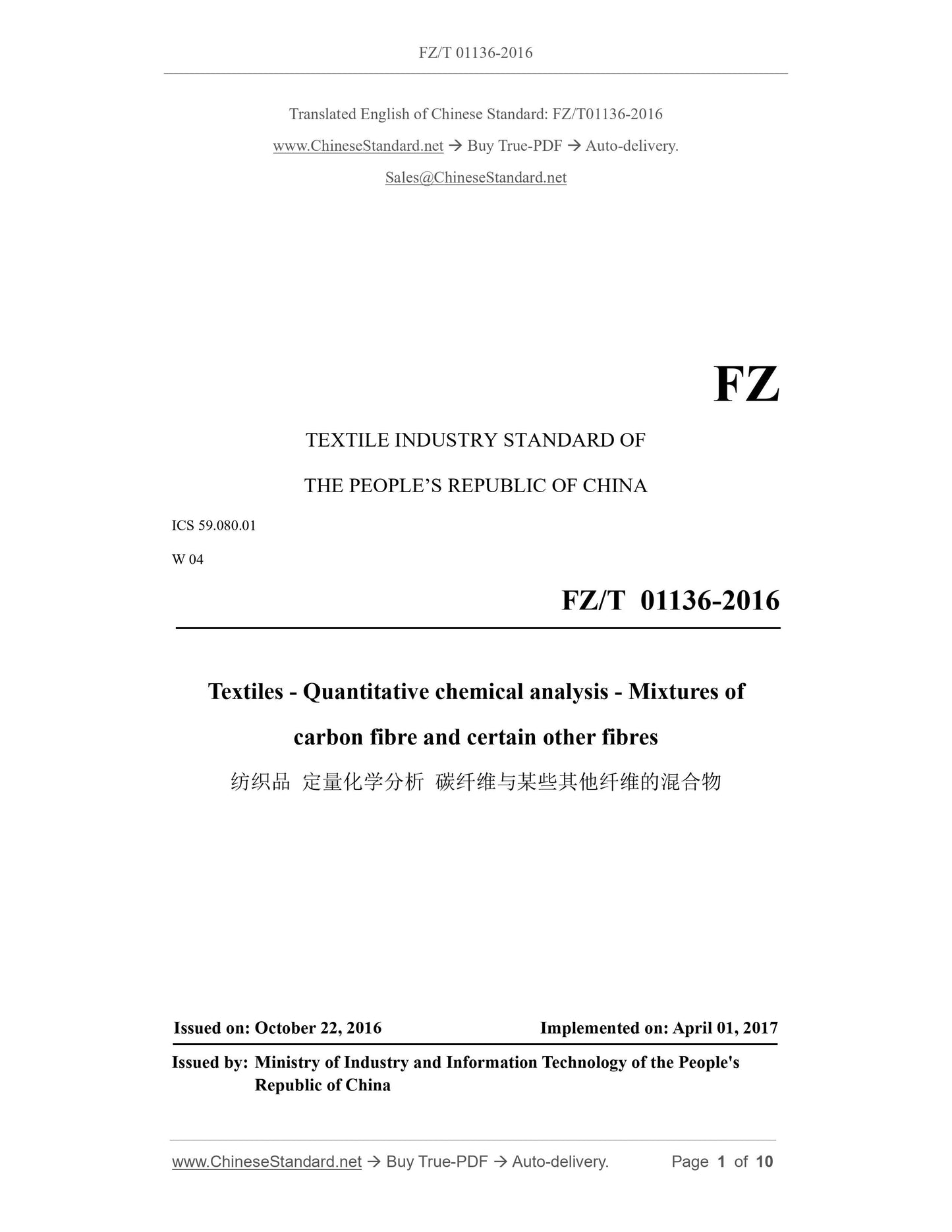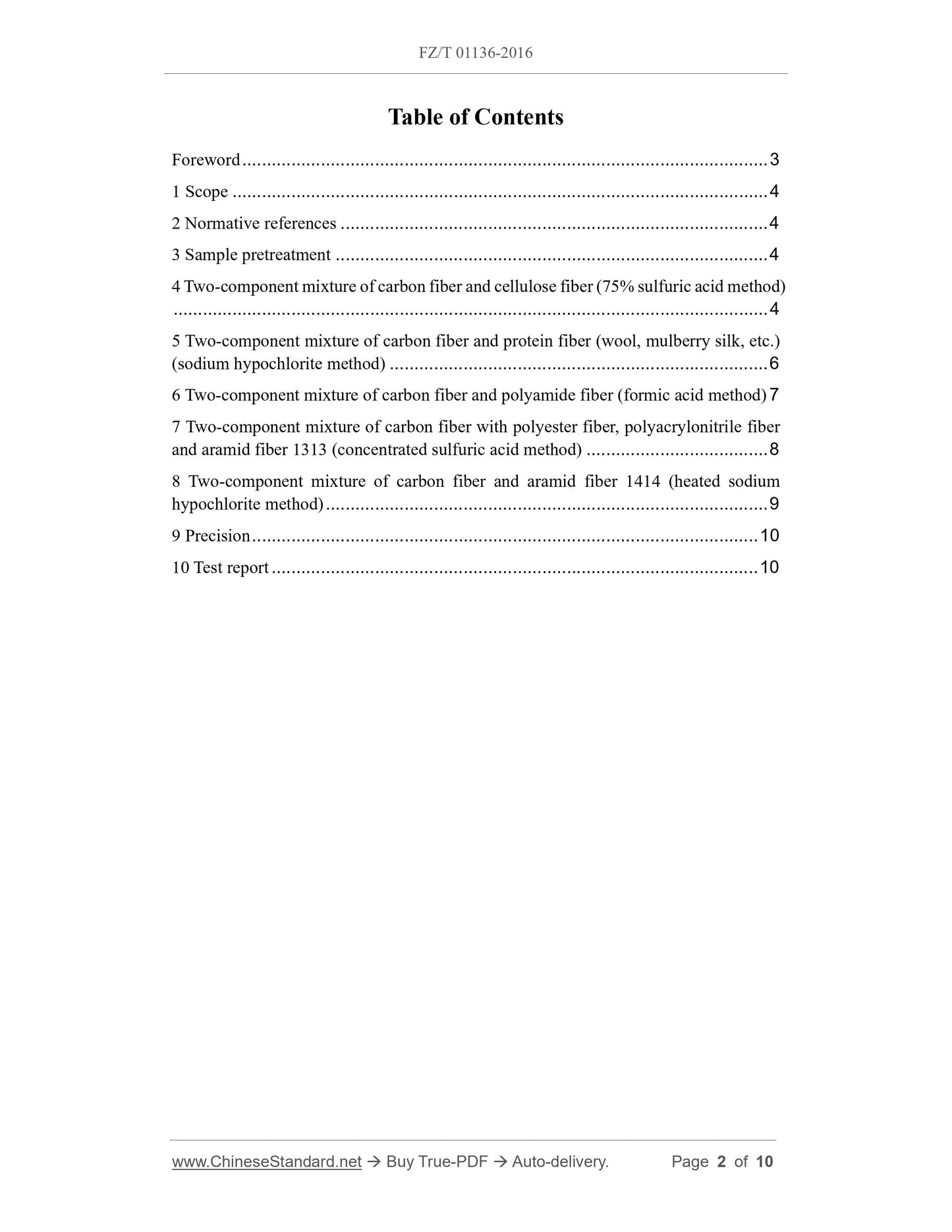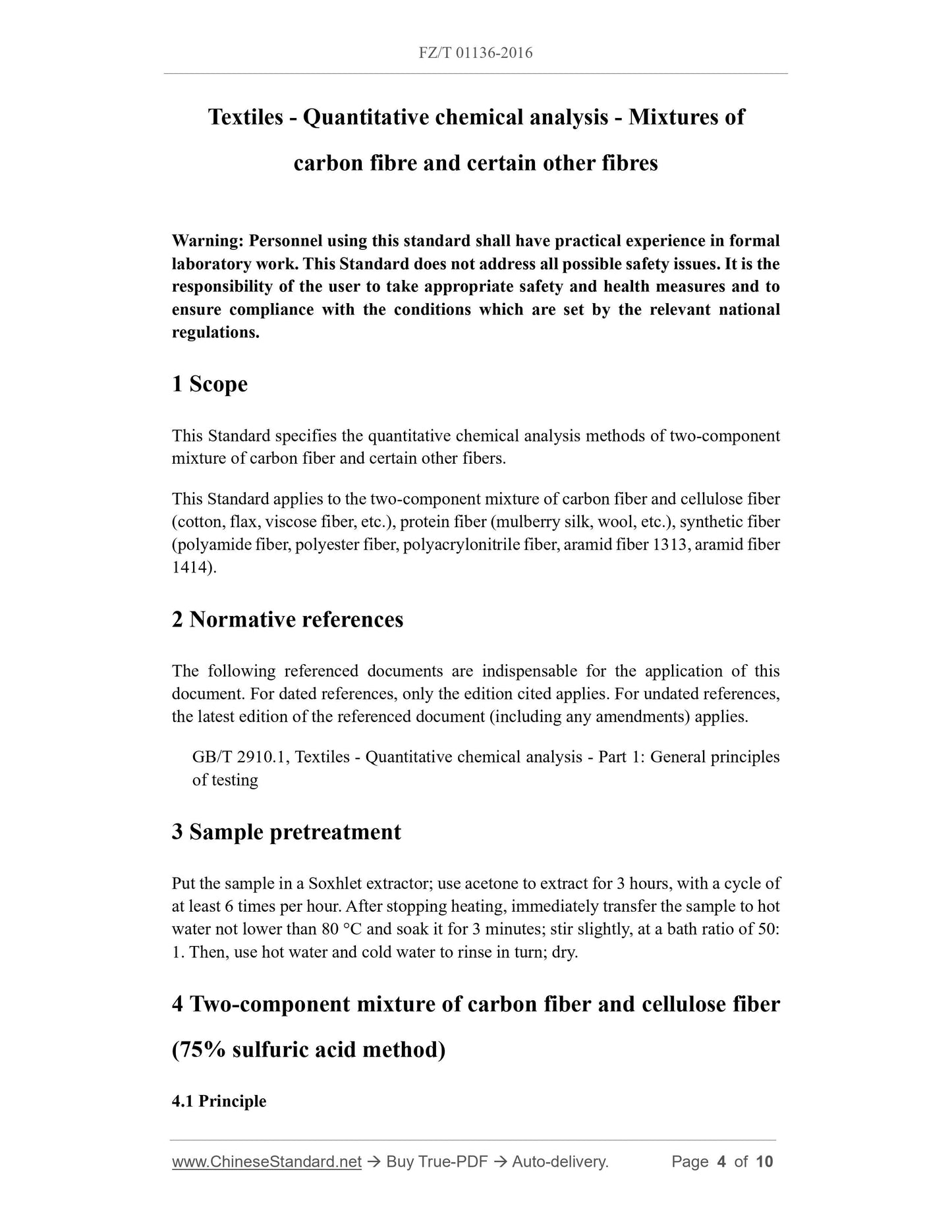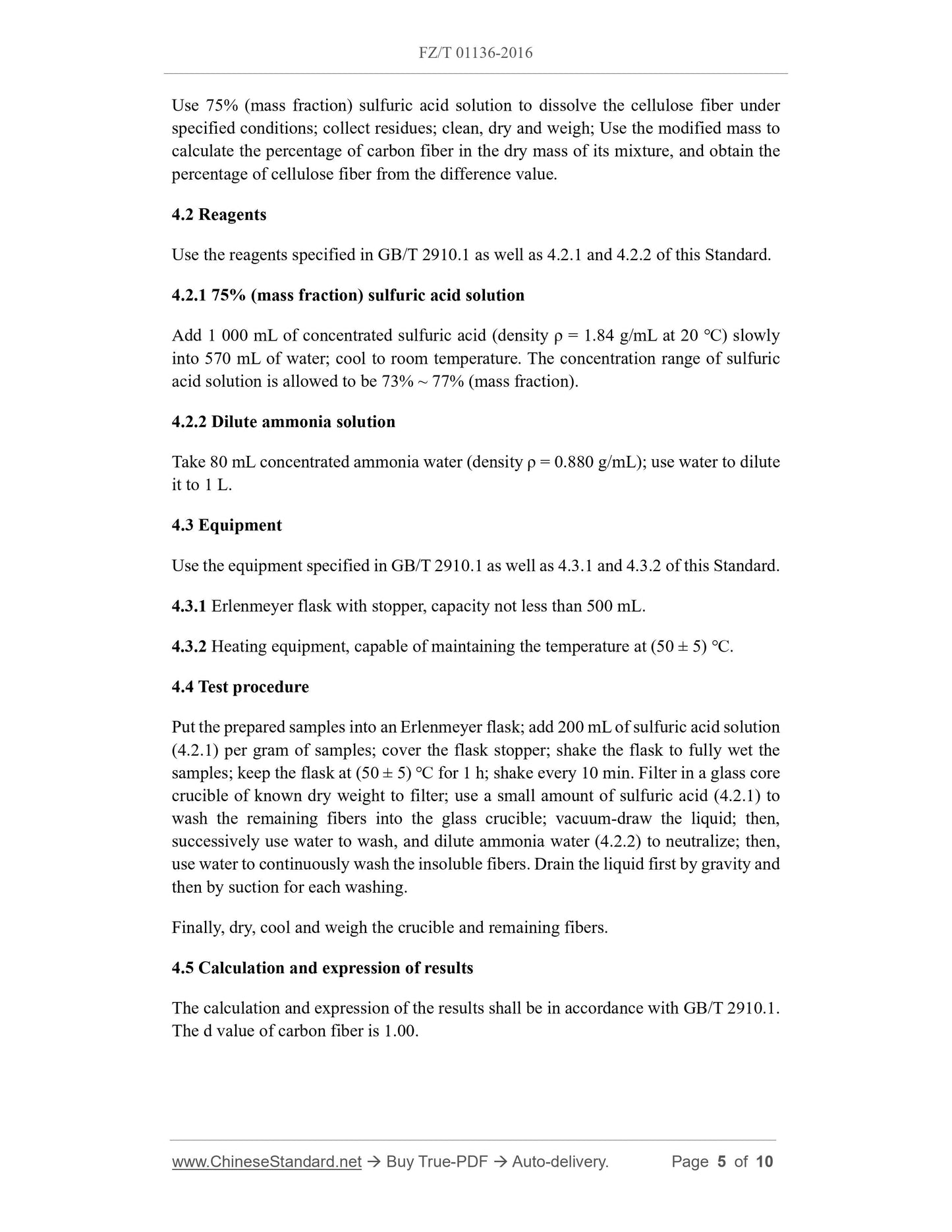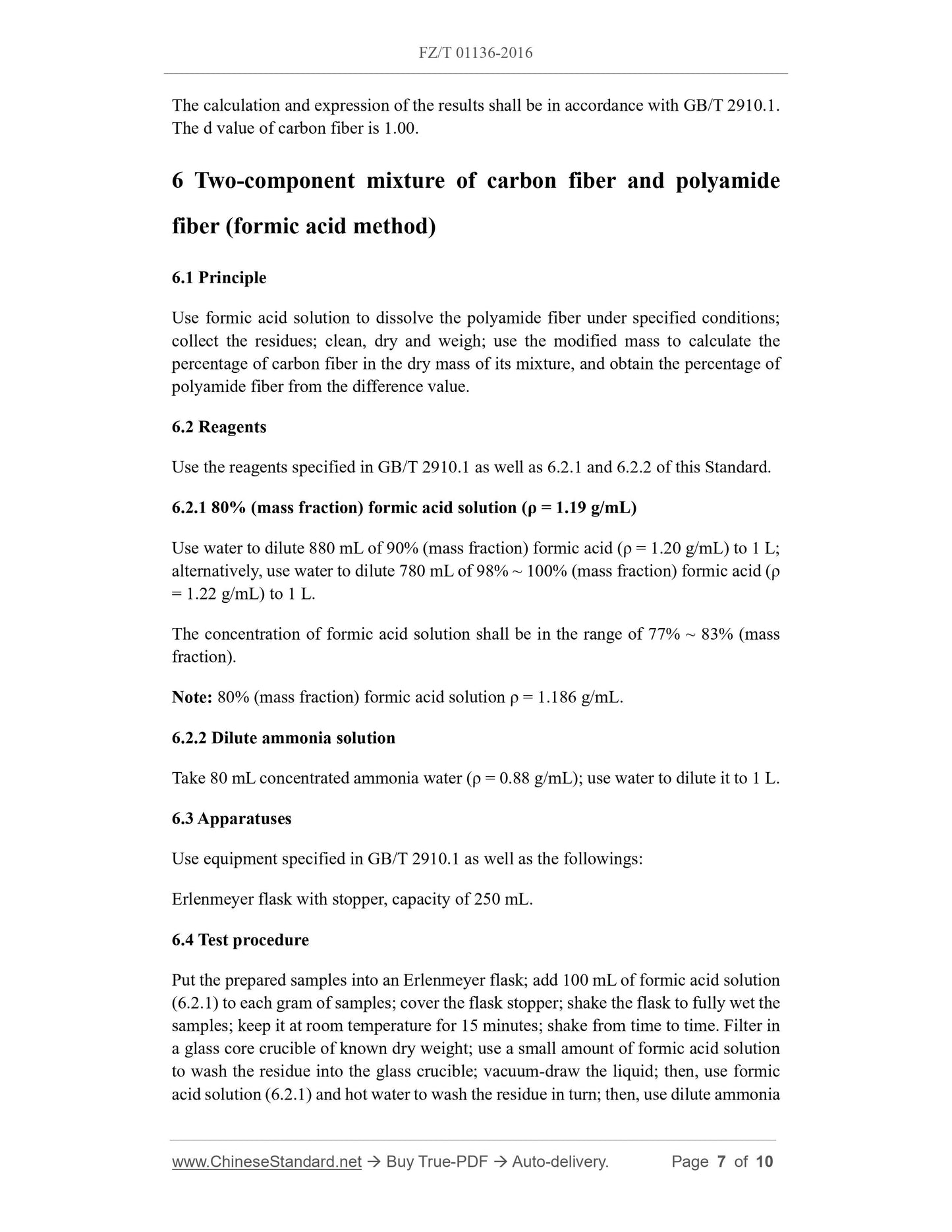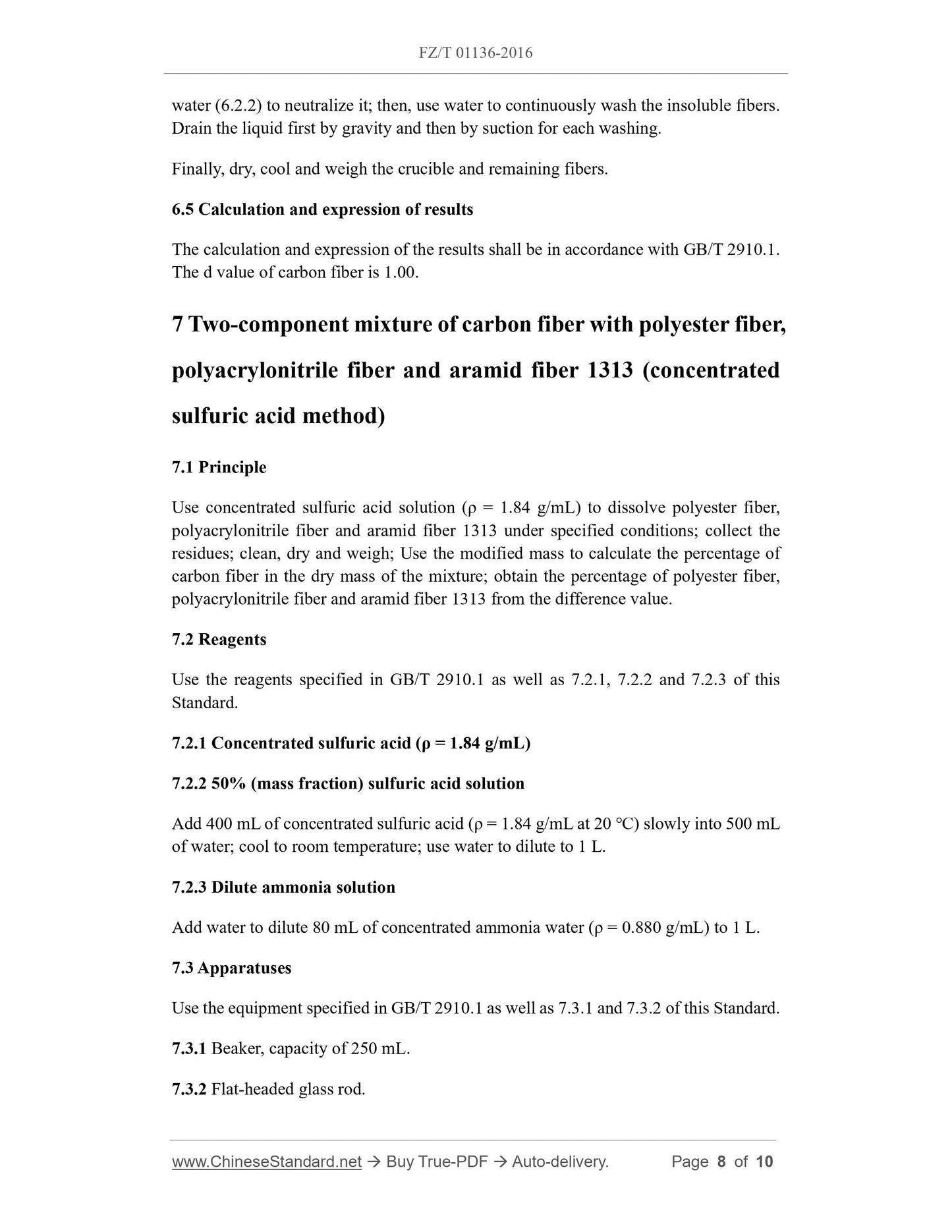PayPal, credit cards. Download editable-PDF and invoice in 1 second!
FZ/T 01136-2016 English PDF (FZT01136-2016)
FZ/T 01136-2016 English PDF (FZT01136-2016)
Precio habitual
$155.00 USD
Precio habitual
Precio de oferta
$155.00 USD
Precio unitario
/
por
Los gastos de envío se calculan en la pantalla de pago.
No se pudo cargar la disponibilidad de retiro
Delivery: 3 seconds. Download true-PDF + Invoice.
Get QUOTATION in 1-minute: Click FZ/T 01136-2016
Historical versions: FZ/T 01136-2016
Preview True-PDF (Reload/Scroll if blank)
FZ/T 01136-2016: Textiles--Quantitative chemical analysis--Mixtures of carbon fibre and certain other fibres
FZ/T 01136-2016
FZ
TEXTILE INDUSTRY STANDARD OF
THE PEOPLE’S REPUBLIC OF CHINA
ICS 59.080.01
W 04
Textiles - Quantitative chemical analysis - Mixtures of
carbon fibre and certain other fibres
ISSUED ON: OCTOBER 22, 2016
IMPLEMENTED ON: APRIL 01, 2017
Issued by: Ministry of Industry and Information Technology of the People's
Republic of China
Table of Contents
Foreword ... 3
1 Scope ... 4
2 Normative references ... 4
3 Sample pretreatment ... 4
4 Two-component mixture of carbon fiber and cellulose fiber (75% sulfuric acid method)
... 4
5 Two-component mixture of carbon fiber and protein fiber (wool, mulberry silk, etc.)
(sodium hypochlorite method) ... 6
6 Two-component mixture of carbon fiber and polyamide fiber (formic acid method) 7
7 Two-component mixture of carbon fiber with polyester fiber, polyacrylonitrile fiber
and aramid fiber 1313 (concentrated sulfuric acid method) ... 8
8 Two-component mixture of carbon fiber and aramid fiber 1414 (heated sodium
hypochlorite method) ... 9
9 Precision ... 10
10 Test report ... 10
Textiles - Quantitative chemical analysis - Mixtures of
carbon fibre and certain other fibres
Warning: Personnel using this standard shall have practical experience in formal
laboratory work. This Standard does not address all possible safety issues. It is the
responsibility of the user to take appropriate safety and health measures and to
ensure compliance with the conditions which are set by the relevant national
regulations.
1 Scope
This Standard specifies the quantitative chemical analysis methods of two-component
mixture of carbon fiber and certain other fibers.
This Standard applies to the two-component mixture of carbon fiber and cellulose fiber
(cotton, flax, viscose fiber, etc.), protein fiber (mulberry silk, wool, etc.), synthetic fiber
(polyamide fiber, polyester fiber, polyacrylonitrile fiber, aramid fiber 1313, aramid fiber
1414).
2 Normative references
The following referenced documents are indispensable for the application of this
document. For dated references, only the edition cited applies. For undated references,
the latest edition of the referenced document (including any amendments) applies.
GB/T 2910.1, Textiles - Quantitative chemical analysis - Part 1: General principles
of testing
3 Sample pretreatment
Put the sample in a Soxhlet extractor; use acetone to extract for 3 hours, with a cycle of
at least 6 times per hour. After stopping heating, immediately transfer the sample to hot
water not lower than 80 °C and soak it for 3 minutes; stir slightly, at a bath ratio of 50:
1. Then, use hot water and cold water to rinse in turn; dry.
4 Two-component mixture of carbon fiber and cellulose fiber
(75% sulfuric acid method)
4.1 Principle
Use 75% (mass fraction) sulfuric acid solution to dissolve the cellulose fiber under
specified conditions; collect residues; clean, dry and weigh; Use the modified mass to
calculate the percentage of carbon fiber in the dry mass of its mixture, and obtain the
percentage of cellulose fiber from the difference value.
4.2 Reagents
Use the reagents specified in GB/T 2910.1 as well as 4.2.1 and 4.2.2 of this Standard.
4.2.1 75% (mass fraction) sulfuric acid solution
Add 1 000 mL of concentrated sulfuric acid (density ρ = 1.84 g/mL at 20 ℃) slowly
into 570 mL of water; cool to room temperature. The concentration range of sulfuric
acid solution is allowed to be 73% ~ 77% (mass fraction).
4.2.2 Dilute ammonia solution
Take 80 mL concentrated ammonia water (density ρ = 0.880 g/mL); use water to dilute
it to 1 L.
4.3 Equipment
Use the equipment specified in GB/T 2910.1 as well as 4.3.1 and 4.3.2 of this Standard.
4.3.1 Erlenmeyer flask with stopper, capacity not less than 500 mL.
4.3.2 Heating equipment, capable of maintaining the temperature at (50 ± 5) ℃.
4.4 Test procedure
Put the prepared samples into an Erlenmeyer flask; add 200 mL of sulfuric acid solution
(4.2.1) per gram of samples; cover the flask stopper; shake the flask to fully wet the
samples; keep the flask at (50 ± 5) ℃ for 1 h; shake every 10 min. Filter in a glass core
crucible of known dry weight to filter; use a small amount of sulfuric acid (4.2.1) to
wash the remaining fibers into the glass crucible; vacuum-draw the liquid; then,
successively use water to wash, and dilute ammonia water (4.2.2) to neutralize; then,
use water to continuously wash the insoluble fibers. Drain the liquid first by gravity and
then by suction for each washing.
Finally, dry, cool and weigh the crucible and remaining fibers.
4.5 Calculation and expression of results
The calculation and expression of the results shall be in accordance with GB/T 2910.1.
The d value of carbon fiber is 1.00.
The calculation and expression of the results shall be in accordance with GB/T 2910.1.
The d value of carbon fiber is 1.00.
6 Two-component mixture of carbon fiber and polyamide
fiber (formic acid method)
6.1 Principle
Use formic acid solution to dissolve the polyamide fiber under specified conditions;
collect the residues; clean, dry and weigh; use the modified mass to calculate the
percentage of carbon fiber in the dry mass of its mixture, and obtain the percentage of
polyamide fiber from the difference value.
6.2 Reagents
Use the reagents specified in GB/T 2910.1 as well as 6.2.1 and 6.2.2 of this Standard.
6.2.1 80% (mass fraction) formic acid solution (ρ = 1.19 g/mL)
Use water to dilute 880 mL of 90% (mass fraction) formic acid (ρ = 1.20 g/mL) to 1 L;
alternatively, use water to dilute 780 mL of 98% ~ 100% (mass fraction) formic acid (ρ
= 1.22 g/mL) to 1 L.
The concentration of formic acid solution shall be in the range of 77% ~ 83% (mass
fraction).
Note: 80% (mass fraction) formic acid solution ρ = 1.186 g/mL.
6.2.2 Dilute ammonia solution
Take 80 mL concentrated ammonia water (ρ = 0.88 g/mL); use water to dilute it to 1 L.
6.3 Apparatuses
Use equipment specified in GB/T 2910.1 as well as the followings:
Erlenmeyer flask with stopper, capacity of 250 mL.
6.4 Test procedure
Put the prepared samples into an Erlenmeyer flask; add 100 mL of formic acid solution
(6.2.1) to each gram of samples; cover the flask stopper; shake the flask to fully wet the
samples; keep it at room temperature for 15 minutes; shake from time to time. Filter in
a glass core crucible of known dry weight; use a small amount of formic acid solution
to wash the residue into the glass crucible; vacuum-draw the liquid; then, use formic
acid solution (6.2.1) and hot water to wash the residue in turn; then, use dilute ammonia
water (6.2.2) to neutralize it; then, use water to continuously wash the insoluble fibers.
Drain the liquid first by gravity and then by suction for each washing.
Finally, dry, cool and weigh the crucible and remaining fibers.
6.5 Calculation and expression of results
The calculation and expression of the results shall be in accordance with GB/T 2910.1.
The d value of carbon fiber is 1.00.
7 Two-component mixture of carbon fiber with polyester fiber,
polyacrylonitrile fiber and aramid fiber 1313 (concentrated
sulfuric acid method)
7.1 Principle
Use concentrated sulfuric acid solution (ρ = 1.84 g/mL) to dissolve polyester fiber,
polyacrylonitrile fiber and aramid fiber 1313 under specified conditions; collect the
residues; clean, dry and weigh; Use the modified mass to calculate the percentage of
carbon fiber in the dry mass of the mixtur...
Get QUOTATION in 1-minute: Click FZ/T 01136-2016
Historical versions: FZ/T 01136-2016
Preview True-PDF (Reload/Scroll if blank)
FZ/T 01136-2016: Textiles--Quantitative chemical analysis--Mixtures of carbon fibre and certain other fibres
FZ/T 01136-2016
FZ
TEXTILE INDUSTRY STANDARD OF
THE PEOPLE’S REPUBLIC OF CHINA
ICS 59.080.01
W 04
Textiles - Quantitative chemical analysis - Mixtures of
carbon fibre and certain other fibres
ISSUED ON: OCTOBER 22, 2016
IMPLEMENTED ON: APRIL 01, 2017
Issued by: Ministry of Industry and Information Technology of the People's
Republic of China
Table of Contents
Foreword ... 3
1 Scope ... 4
2 Normative references ... 4
3 Sample pretreatment ... 4
4 Two-component mixture of carbon fiber and cellulose fiber (75% sulfuric acid method)
... 4
5 Two-component mixture of carbon fiber and protein fiber (wool, mulberry silk, etc.)
(sodium hypochlorite method) ... 6
6 Two-component mixture of carbon fiber and polyamide fiber (formic acid method) 7
7 Two-component mixture of carbon fiber with polyester fiber, polyacrylonitrile fiber
and aramid fiber 1313 (concentrated sulfuric acid method) ... 8
8 Two-component mixture of carbon fiber and aramid fiber 1414 (heated sodium
hypochlorite method) ... 9
9 Precision ... 10
10 Test report ... 10
Textiles - Quantitative chemical analysis - Mixtures of
carbon fibre and certain other fibres
Warning: Personnel using this standard shall have practical experience in formal
laboratory work. This Standard does not address all possible safety issues. It is the
responsibility of the user to take appropriate safety and health measures and to
ensure compliance with the conditions which are set by the relevant national
regulations.
1 Scope
This Standard specifies the quantitative chemical analysis methods of two-component
mixture of carbon fiber and certain other fibers.
This Standard applies to the two-component mixture of carbon fiber and cellulose fiber
(cotton, flax, viscose fiber, etc.), protein fiber (mulberry silk, wool, etc.), synthetic fiber
(polyamide fiber, polyester fiber, polyacrylonitrile fiber, aramid fiber 1313, aramid fiber
1414).
2 Normative references
The following referenced documents are indispensable for the application of this
document. For dated references, only the edition cited applies. For undated references,
the latest edition of the referenced document (including any amendments) applies.
GB/T 2910.1, Textiles - Quantitative chemical analysis - Part 1: General principles
of testing
3 Sample pretreatment
Put the sample in a Soxhlet extractor; use acetone to extract for 3 hours, with a cycle of
at least 6 times per hour. After stopping heating, immediately transfer the sample to hot
water not lower than 80 °C and soak it for 3 minutes; stir slightly, at a bath ratio of 50:
1. Then, use hot water and cold water to rinse in turn; dry.
4 Two-component mixture of carbon fiber and cellulose fiber
(75% sulfuric acid method)
4.1 Principle
Use 75% (mass fraction) sulfuric acid solution to dissolve the cellulose fiber under
specified conditions; collect residues; clean, dry and weigh; Use the modified mass to
calculate the percentage of carbon fiber in the dry mass of its mixture, and obtain the
percentage of cellulose fiber from the difference value.
4.2 Reagents
Use the reagents specified in GB/T 2910.1 as well as 4.2.1 and 4.2.2 of this Standard.
4.2.1 75% (mass fraction) sulfuric acid solution
Add 1 000 mL of concentrated sulfuric acid (density ρ = 1.84 g/mL at 20 ℃) slowly
into 570 mL of water; cool to room temperature. The concentration range of sulfuric
acid solution is allowed to be 73% ~ 77% (mass fraction).
4.2.2 Dilute ammonia solution
Take 80 mL concentrated ammonia water (density ρ = 0.880 g/mL); use water to dilute
it to 1 L.
4.3 Equipment
Use the equipment specified in GB/T 2910.1 as well as 4.3.1 and 4.3.2 of this Standard.
4.3.1 Erlenmeyer flask with stopper, capacity not less than 500 mL.
4.3.2 Heating equipment, capable of maintaining the temperature at (50 ± 5) ℃.
4.4 Test procedure
Put the prepared samples into an Erlenmeyer flask; add 200 mL of sulfuric acid solution
(4.2.1) per gram of samples; cover the flask stopper; shake the flask to fully wet the
samples; keep the flask at (50 ± 5) ℃ for 1 h; shake every 10 min. Filter in a glass core
crucible of known dry weight to filter; use a small amount of sulfuric acid (4.2.1) to
wash the remaining fibers into the glass crucible; vacuum-draw the liquid; then,
successively use water to wash, and dilute ammonia water (4.2.2) to neutralize; then,
use water to continuously wash the insoluble fibers. Drain the liquid first by gravity and
then by suction for each washing.
Finally, dry, cool and weigh the crucible and remaining fibers.
4.5 Calculation and expression of results
The calculation and expression of the results shall be in accordance with GB/T 2910.1.
The d value of carbon fiber is 1.00.
The calculation and expression of the results shall be in accordance with GB/T 2910.1.
The d value of carbon fiber is 1.00.
6 Two-component mixture of carbon fiber and polyamide
fiber (formic acid method)
6.1 Principle
Use formic acid solution to dissolve the polyamide fiber under specified conditions;
collect the residues; clean, dry and weigh; use the modified mass to calculate the
percentage of carbon fiber in the dry mass of its mixture, and obtain the percentage of
polyamide fiber from the difference value.
6.2 Reagents
Use the reagents specified in GB/T 2910.1 as well as 6.2.1 and 6.2.2 of this Standard.
6.2.1 80% (mass fraction) formic acid solution (ρ = 1.19 g/mL)
Use water to dilute 880 mL of 90% (mass fraction) formic acid (ρ = 1.20 g/mL) to 1 L;
alternatively, use water to dilute 780 mL of 98% ~ 100% (mass fraction) formic acid (ρ
= 1.22 g/mL) to 1 L.
The concentration of formic acid solution shall be in the range of 77% ~ 83% (mass
fraction).
Note: 80% (mass fraction) formic acid solution ρ = 1.186 g/mL.
6.2.2 Dilute ammonia solution
Take 80 mL concentrated ammonia water (ρ = 0.88 g/mL); use water to dilute it to 1 L.
6.3 Apparatuses
Use equipment specified in GB/T 2910.1 as well as the followings:
Erlenmeyer flask with stopper, capacity of 250 mL.
6.4 Test procedure
Put the prepared samples into an Erlenmeyer flask; add 100 mL of formic acid solution
(6.2.1) to each gram of samples; cover the flask stopper; shake the flask to fully wet the
samples; keep it at room temperature for 15 minutes; shake from time to time. Filter in
a glass core crucible of known dry weight; use a small amount of formic acid solution
to wash the residue into the glass crucible; vacuum-draw the liquid; then, use formic
acid solution (6.2.1) and hot water to wash the residue in turn; then, use dilute ammonia
water (6.2.2) to neutralize it; then, use water to continuously wash the insoluble fibers.
Drain the liquid first by gravity and then by suction for each washing.
Finally, dry, cool and weigh the crucible and remaining fibers.
6.5 Calculation and expression of results
The calculation and expression of the results shall be in accordance with GB/T 2910.1.
The d value of carbon fiber is 1.00.
7 Two-component mixture of carbon fiber with polyester fiber,
polyacrylonitrile fiber and aramid fiber 1313 (concentrated
sulfuric acid method)
7.1 Principle
Use concentrated sulfuric acid solution (ρ = 1.84 g/mL) to dissolve polyester fiber,
polyacrylonitrile fiber and aramid fiber 1313 under specified conditions; collect the
residues; clean, dry and weigh; Use the modified mass to calculate the percentage of
carbon fiber in the dry mass of the mixtur...
Share
